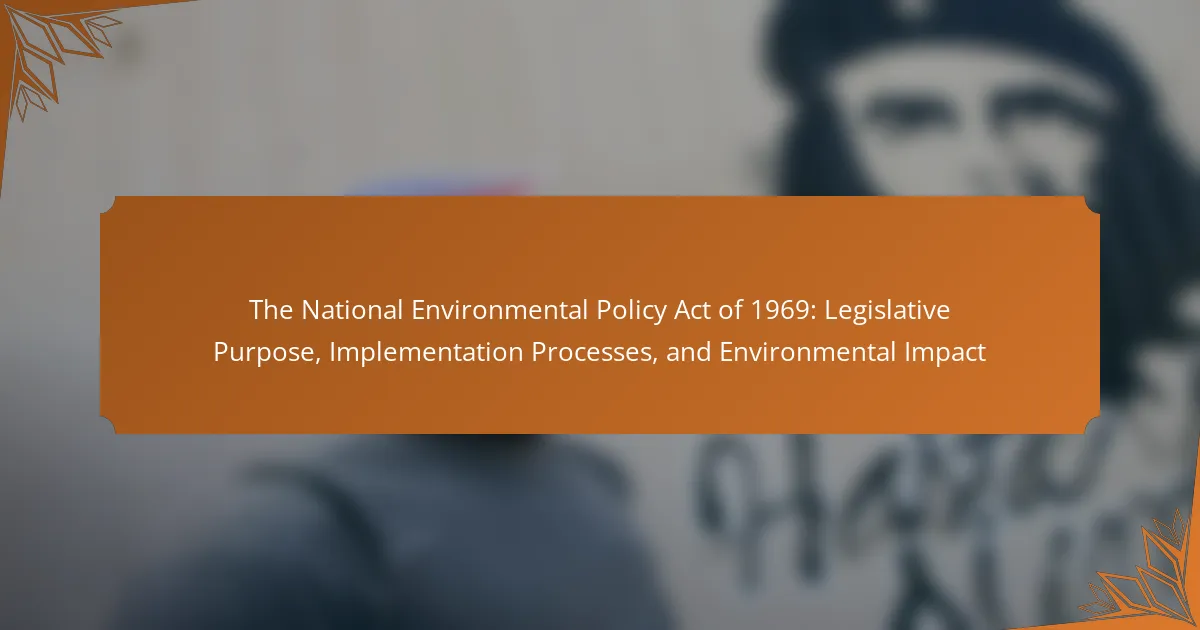The National Environmental Policy Act of 1969 (NEPA) is a foundational U.S. federal law designed to promote environmental protection in federal decision-making. NEPA requires federal agencies to evaluate the environmental impacts of proposed actions through Environmental Assessments (EAs) and Environmental Impact Statements (EISs). The act establishes a structured process that includes public input and culminates in a Record of Decision (ROD) to ensure informed decision-making. NEPA has significantly influenced U.S. environmental policy, enhancing awareness and leading to project modifications that minimize ecological harm. The Council on Environmental Quality (CEQ) oversees NEPA’s implementation, guiding agencies in integrating environmental considerations into their planning and development processes.

What is the National Environmental Policy Act of 1969?
The National Environmental Policy Act of 1969 (NEPA) is a United States federal law. It was enacted to promote environmental protection during federal agency decision-making. NEPA requires federal agencies to assess the environmental effects of their proposed actions. This includes preparing detailed Environmental Impact Statements (EIS) for significant projects. The law aims to ensure that all branches of government consider the environment before undertaking any major federal action. NEPA also established the Council on Environmental Quality (CEQ) to oversee its implementation. The act has played a crucial role in shaping environmental policy in the U.S. since its passage.
Why was the National Environmental Policy Act enacted?
The National Environmental Policy Act was enacted to promote environmental protection and ensure that federal agencies consider environmental impacts in their decision-making. The act requires federal agencies to prepare Environmental Assessments and Environmental Impact Statements for major projects. This process aims to inform decision-makers and the public about potential environmental effects. The NEPA was signed into law on January 1, 1970, in response to growing public concern about environmental degradation. It established a framework for environmental review and public participation. The act has led to increased transparency and accountability in federal projects. NEPA has shaped environmental policy and planning in the United States since its enactment.
What historical context led to the creation of the National Environmental Policy Act?
The National Environmental Policy Act (NEPA) was created in response to growing environmental concerns in the 1960s. Increased industrialization and urbanization led to significant environmental degradation. Events like the Santa Barbara oil spill in 1969 highlighted the need for federal environmental oversight. Public awareness of pollution and habitat destruction surged during this era. Influential publications, such as Rachel Carson’s “Silent Spring,” raised awareness about environmental issues. The environmental movement gained momentum, leading to widespread advocacy for policy changes. NEPA was signed into law on January 1, 1970, establishing a framework for environmental assessments. This act aimed to ensure that federal agencies consider environmental impacts in their decision-making processes.
What are the key objectives of the National Environmental Policy Act?
The key objectives of the National Environmental Policy Act (NEPA) are to promote environmental protection and ensure informed decision-making. NEPA requires federal agencies to assess the environmental effects of their proposed actions. This includes preparing detailed statements on the environmental impact of major federal actions. Public involvement is a critical component of the NEPA process. The act aims to foster transparency and accountability in governmental planning. NEPA was enacted in 1969, establishing a national framework for environmental review. It emphasizes the importance of considering environmental factors alongside economic and technical factors. Overall, NEPA aims to enhance the quality of the environment for present and future generations.
How does the National Environmental Policy Act influence environmental policy?
The National Environmental Policy Act (NEPA) establishes a framework for environmental decision-making. It requires federal agencies to assess environmental impacts of their proposed actions. This assessment process involves preparing Environmental Assessments (EAs) and Environmental Impact Statements (EISs). NEPA’s influence ensures that environmental factors are considered before project approvals. It promotes public involvement in the decision-making process. NEPA also sets a precedent for state and local environmental regulations. Since its enactment in 1969, NEPA has shaped environmental policy across various sectors. The act has led to more sustainable practices in federal projects.
What role does the National Environmental Policy Act play in federal decision-making?
The National Environmental Policy Act (NEPA) requires federal agencies to assess environmental impacts before making decisions. NEPA mandates the preparation of Environmental Assessments (EAs) and Environmental Impact Statements (EISs). These documents evaluate potential effects on the environment and consider alternatives. The process promotes informed decision-making by ensuring environmental factors are considered. NEPA also encourages public participation and transparency in federal projects. This involvement helps to identify concerns and improve project outcomes. Since its enactment in 1969, NEPA has influenced numerous federal actions and policies. Its role is crucial in integrating environmental considerations into federal decision-making processes.
How does the National Environmental Policy Act integrate environmental considerations into planning?
The National Environmental Policy Act (NEPA) integrates environmental considerations into planning by requiring federal agencies to assess the environmental impacts of their proposed actions. NEPA mandates the preparation of Environmental Assessments (EAs) and Environmental Impact Statements (EISs) for major federal projects. These documents evaluate potential effects on the environment and consider alternatives to minimize harm. Public involvement is a critical component of this process, allowing stakeholders to provide input. This ensures that environmental factors are weighed alongside economic and technical considerations in decision-making. NEPA has been instrumental in promoting sustainable development practices since its enactment in 1969.

What are the implementation processes of the National Environmental Policy Act?
The implementation processes of the National Environmental Policy Act (NEPA) involve several key steps. First, federal agencies must assess the environmental impacts of their proposed actions. This is done through Environmental Assessments (EAs) or Environmental Impact Statements (EISs). An EA is a concise document that evaluates the potential environmental effects. If significant effects are identified, an EIS is required.
The EIS process includes scoping, which gathers input from the public and stakeholders. Following this, the agency drafts the EIS, detailing the proposed action and its potential impacts. The draft EIS is then made available for public comment. After reviewing comments, the agency finalizes the EIS.
Once the EIS is complete, the agency issues a Record of Decision (ROD) that outlines the chosen course of action. This process ensures that environmental considerations are integrated into federal decision-making. NEPA’s implementation is guided by regulations established by the Council on Environmental Quality (CEQ).
What are the steps involved in the National Environmental Policy Act review process?
The National Environmental Policy Act (NEPA) review process includes several key steps. First, an agency identifies the need for action and determines if NEPA applies. Next, the agency conducts scoping to identify relevant issues and concerns. Then, the agency prepares an Environmental Assessment (EA) or Environmental Impact Statement (EIS) depending on the potential impact. After that, the agency solicits public comments on the EA or EIS draft. Following this, the agency reviews the comments and may revise the document. Finally, the agency issues a Record of Decision (ROD) that outlines the chosen course of action. These steps ensure that environmental considerations are integrated into federal decision-making.
How are Environmental Assessments conducted under the National Environmental Policy Act?
Environmental Assessments (EAs) under the National Environmental Policy Act (NEPA) are conducted through a systematic process. This process begins with determining whether an EA is necessary for a proposed federal action. The federal agency responsible for the action typically initiates this assessment.
Next, the agency evaluates the potential environmental impacts of the proposed action. This evaluation includes analyzing alternative actions and their effects. The agency must consider both direct and indirect impacts on the environment.
Public involvement is also a crucial component of the EA process. Agencies often solicit input from stakeholders and the public. This input can help identify significant environmental issues that may need further consideration.
After completing the assessment, the agency prepares a draft EA. This document outlines the proposed action, the environmental impacts, and any alternatives. The draft EA is made available for public review and comment.
Following the review period, the agency finalizes the EA. If the EA determines that the proposed action will not significantly affect the environment, a Finding of No Significant Impact (FONSI) is issued. If significant impacts are identified, the agency may need to prepare an Environmental Impact Statement (EIS) instead.
This process ensures that environmental factors are considered in federal decision-making. NEPA requires agencies to take a hard look at the potential environmental consequences of their actions.
What is the significance of Environmental Impact Statements in the National Environmental Policy Act process?
Environmental Impact Statements (EIS) are crucial in the National Environmental Policy Act (NEPA) process. They provide a detailed analysis of the potential environmental effects of proposed federal actions. An EIS ensures that all environmental impacts are considered before decisions are made. This process promotes informed decision-making and public participation. It also helps to identify alternatives and mitigative measures. NEPA requires an EIS for major federal actions significantly affecting the environment. The EIS process enhances transparency and accountability in governmental projects. It serves as a tool for environmental protection and sustainable development.
Who is responsible for implementing the National Environmental Policy Act?
The Council on Environmental Quality (CEQ) is responsible for implementing the National Environmental Policy Act (NEPA). NEPA was enacted in 1969 to promote environmental protection during federal agency decision-making. The CEQ oversees the federal implementation of NEPA’s requirements. This includes ensuring that federal agencies prepare environmental assessments and environmental impact statements. The CEQ also provides guidance and regulations to facilitate compliance with NEPA. Additionally, federal agencies are responsible for adhering to NEPA’s provisions in their projects and actions.
What roles do federal agencies play in the implementation of the National Environmental Policy Act?
Federal agencies are responsible for implementing the National Environmental Policy Act (NEPA). They must assess the environmental impacts of proposed federal actions. This includes preparing Environmental Assessments (EAs) and Environmental Impact Statements (EISs). Federal agencies also engage in public involvement during the review process. They are required to consider alternatives and mitigation measures. Additionally, agencies must coordinate with other federal, state, and local agencies. Compliance with NEPA is mandatory for federal projects. This ensures that environmental factors are weighed in decision-making processes. The Council on Environmental Quality oversees the implementation of NEPA guidelines.
How do state and local governments interact with the National Environmental Policy Act?
State and local governments interact with the National Environmental Policy Act (NEPA) by integrating its requirements into their own environmental review processes. NEPA mandates federal agencies to assess environmental impacts before making decisions. State and local governments often collaborate with federal agencies to ensure compliance. They may adopt similar review procedures to streamline projects. Additionally, they participate in public comment periods established by NEPA. This allows them to voice concerns and influence federal decisions. Some states have their own environmental laws that complement NEPA. These laws may impose stricter standards or additional review processes. Overall, state and local governments play a crucial role in the implementation of NEPA at various levels.

What is the environmental impact of the National Environmental Policy Act?
The National Environmental Policy Act (NEPA) mandates federal agencies to assess environmental impacts before undertaking major projects. This requirement promotes informed decision-making and public participation. NEPA’s impact includes enhanced environmental protection and awareness. It has led to the identification of potential adverse effects on ecosystems and communities. Studies show that NEPA reviews often result in project modifications to minimize harm. For instance, the Council on Environmental Quality reported that NEPA has improved project planning and reduced negative environmental outcomes. Overall, NEPA fosters a more sustainable approach to federal development activities.
How has the National Environmental Policy Act affected environmental protection efforts?
The National Environmental Policy Act (NEPA) has significantly influenced environmental protection efforts in the United States. NEPA established a framework for evaluating the environmental impacts of federal actions. It requires federal agencies to prepare Environmental Assessments (EAs) and Environmental Impact Statements (EISs) for major projects. This process ensures that environmental factors are considered in decision-making. As a result, NEPA has led to increased public participation in environmental reviews. The act has also prompted the adoption of more sustainable practices in project planning. Since its enactment in 1969, NEPA has been a critical tool for environmental advocacy. Studies show that NEPA has contributed to the preservation of ecosystems and wildlife habitats. Overall, NEPA has strengthened the integration of environmental considerations into federal policy.
What evidence exists to support the effectiveness of the National Environmental Policy Act?
The National Environmental Policy Act (NEPA) has demonstrated effectiveness through various studies and reports. Research indicates that NEPA has improved environmental decision-making processes. A study by the U.S. Government Accountability Office found that NEPA reviews often lead to better environmental outcomes. Additionally, NEPA has facilitated public participation in environmental assessments. The act has also resulted in the identification of alternative project designs that minimize environmental harm. A report by the Council on Environmental Quality highlighted that NEPA has increased awareness of environmental issues among federal agencies. Overall, these findings collectively support the effectiveness of NEPA in promoting environmental protection and informed decision-making.
How does the National Environmental Policy Act contribute to public awareness of environmental issues?
The National Environmental Policy Act (NEPA) increases public awareness of environmental issues through mandated environmental assessments. NEPA requires federal agencies to evaluate the environmental impacts of their proposed actions. This evaluation process involves public participation and comment periods. Citizens can access information about potential environmental effects through Environmental Impact Statements (EIS). The EIS documents are made available to the public, fostering transparency. Public involvement in the NEPA process encourages community engagement. This engagement helps to inform and educate the public about environmental concerns. Overall, NEPA serves as a tool for raising awareness and promoting informed public discourse on environmental issues.
What challenges does the National Environmental Policy Act face in today’s context?
The National Environmental Policy Act (NEPA) faces several challenges today. One significant challenge is the increasing complexity of environmental assessments. Projects often require extensive data and analysis, which can delay the review process. Additionally, there is pressure from economic interests to expedite project approvals. This pressure can lead to conflicts between development and environmental protection.
Another challenge is the evolving understanding of environmental issues. Climate change, biodiversity loss, and pollution require updated methodologies in impact assessments. Furthermore, there are legal challenges regarding NEPA’s implementation. Courts have sometimes ruled against federal agencies for inadequate environmental reviews.
Public engagement has also become more complicated. Stakeholders often have diverse and conflicting interests, making consensus difficult. Finally, funding and resources for environmental reviews are often limited, hindering effective implementation of NEPA. These challenges collectively threaten the effectiveness of NEPA in safeguarding the environment.
How do political and economic factors influence the National Environmental Policy Act’s effectiveness?
Political and economic factors significantly influence the effectiveness of the National Environmental Policy Act (NEPA). Political priorities can shift, impacting funding and support for environmental reviews. For instance, administrations focused on economic growth may prioritize development over environmental protections. Economic conditions can also affect the resources available for compliance with NEPA requirements. During economic downturns, agencies may face budget cuts, limiting their capacity to conduct thorough environmental assessments. Additionally, lobbying by industries can lead to weakened regulations, undermining NEPA’s intent. Historical examples include the rollback of certain environmental protections during economic crises, illustrating how these factors can hinder NEPA’s effectiveness.
What improvements or reforms are being proposed for the National Environmental Policy Act?
Proposed improvements for the National Environmental Policy Act (NEPA) include streamlining the review process and increasing efficiency. These reforms aim to reduce the time taken for environmental reviews. The proposed changes also focus on enhancing public participation in the process. Additionally, there is a push for clearer guidelines on what constitutes a significant environmental impact. The reforms are intended to balance environmental protection with economic development. Recent discussions emphasize the need for modernizing NEPA to address current environmental challenges. These proposals are backed by various stakeholders, including government agencies and environmental organizations.
What best practices can be adopted for effective compliance with the National Environmental Policy Act?
Effective compliance with the National Environmental Policy Act (NEPA) requires several best practices. First, agencies should conduct thorough environmental assessments (EAs) and environmental impact statements (EISs) as mandated by NEPA. This ensures that potential environmental impacts are identified and addressed. Second, early and continuous public involvement is essential. Engaging stakeholders from the beginning fosters transparency and gathers valuable input. Third, agencies should maintain clear documentation of the decision-making process. This provides a record that can be reviewed for compliance and accountability. Fourth, training personnel in NEPA procedures is crucial. Well-informed staff can navigate the compliance process more effectively. Finally, adopting adaptive management strategies allows agencies to adjust their approaches based on new information or changing circumstances. These practices help ensure that NEPA’s objectives are met and that environmental considerations are integrated into federal decision-making.
The National Environmental Policy Act of 1969 (NEPA) is a federal law aimed at promoting environmental protection in federal decision-making processes. The act mandates federal agencies to assess the environmental impacts of proposed actions through Environmental Assessments (EAs) and Environmental Impact Statements (EISs), ensuring informed decision-making and public participation. NEPA established the Council on Environmental Quality (CEQ) to oversee its implementation, enhancing transparency and accountability in federal projects. This article explores NEPA’s legislative purpose, implementation processes, and its significant impact on environmental policy and protection efforts in the United States.



